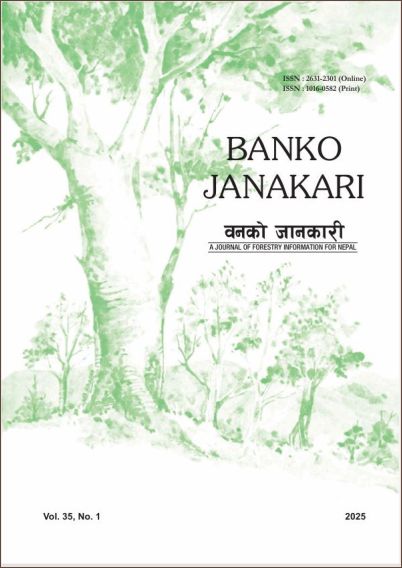Evaluation of cytotoxicity and antidiabetic activities of plant extracts used in Triphala from western Nepal using different solvents
DOI:
https://doi.org/10.3126/banko.v35i1.73002Keywords:
Medicinal plants, antidiabetic, Brine shrimp lethality, Triphala, Various solventsAbstract
The Triphala plants: Phyllantus emblica, Terminalia chebula and Terminalia bellirica have been traditionally used in the treatment of various aliments since prehistoric times. Their antidiabetic activity, particularly against α-amylase enzyme, has been reported in studies from different countries. However, limited research has evaluated the antidiabetic potential of Triphala plants originating from Nepal using solvents like hexane, ethylacetate and water. In this study, extraction of the plants was carried out using the Soxhlet method with the solvents. The antidiabetic activity was evaluated through an α-amylase enzyme inhibition assay, while cytotoxic effect was determined through the brine shrimp lethality assay. Among the extracts, the highest percentage yield was obtained from the aqueous extract of T. chebula (7.17%), while the lowest was from the hexane extract of P. emblica (1.28%). The aqueous extracts of T. chebula demonstrated the highest antidiabetic potential with an IC50 value of 97.86 ± 0.17 µg/mL, forming the smallest polygon in the radar diagram, whereas the least potential was exhibited by the hexane extract of P. emblica (IC50 = 810.85 ± 2.05 µg/mL; 0.81 mg/mL), forming the largest polygon in the radar diagram. Regarding safety, the cytotoxicity of these extracts was assessed using the brine shrimp lethality assay. The hexane extract of P. emblica exhibited the least toxicity (LC50 = 8.54 mg/ mL). In contrast, the aqueous extract of T. cheubla showed the highest toxicity with an LC50 of 0.99 mg/mL.
Downloads
Downloads
Published
How to Cite
Issue
Section
License
Copyright (c) 2025 Forest Research and Training Centre

This work is licensed under a Creative Commons Attribution-NonCommercial 4.0 International License.
© Forest Research and Training Centre, Ministry of Forests and Environment, Nepal




